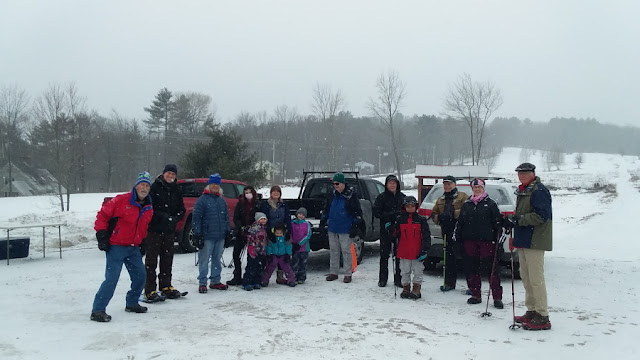I know it's way too early to think about spring, but when I saw the first green shoots pushing up from the frozen ground, I couldn't help it.
 |
| Snowdrops - the first plants of spring. |
These are snowdrops, and they're always the first plants to arrive in the new year, often well before the snow is gone. Even though they're cheating by being right beside the house it's still reassuring to see new life sprouting from the earth. Being February, there are still many cold nights to come, certainly bringing temperatures well below freezing; most likely we'll see single digits if not negative numbers repeatedly over the next several weeks. In fact, this is what they look like this morning at nine degrees:
 |
| Buried in snow at nine degrees Fahrenheit. |
I've always wondered how these plants can survive those temperatures after they've sprouted, so I went in search of the answer. I found the information I was looking for in a report called "The Science of Snowdrops" from biotech education company Edvotech (among other sources).
Snowdrops are native to the high mountains of Europe where they evolved the ability to create something called "antifreeze proteins" that protect their cells from freeze damage in cold weather. These proteins adhere to tiny ice crystals as they begin to form, creating a barrier that blocks additional water from adding to crystal. This prevents the crystal from getting larger, and it's large, expanding crystals that burst cells in plants and kill them. Other plants and animals (such as the wood frog that can survive freezing temperatures during hibernation) have glycerol or sugars in their cells which let them survive temperatures slightly below freezing, but the antifreeze proteins in snowdrops gives them protection against the much lower temperatures they will experience above the ground in February and March. If all goes according to plan these snowdrops will survive the remaining weeks of winter and I'll see their pretty white blossoms in just a few weeks.
As often happens, researching one topic leads to discovery in other areas. Snowdrops also contain the molecule galantamine which is an Acetylcholinesterase inhibitor. The enzyme Acetylcholinesterase breaks down neurotransmitters between nerve cells and muscle cells. By inhibiting Acetylcholinesterase, galantamine has been shown to benefit Alzheimer patients and is the main ingredient in the drug Razadyne.
This little winter bloomer contains a lot of power and may provide even more beauty to the world as scientists dig into all its secrets.
 |
| March 22, last year. |
Although the gray squirrels have been at the bird feeders for weeks, the first red squirrel just appeared which makes we wonder if their winter stores are starting to dwindle.
 |
| This gray squirrel does its best to keep the others away from "its" feeder. |
I also see lots of signs of red squirrels digging down through the snow to extract hemlock cones and acorns.
 |
| A pile of acorn shells dug up and peeled open by a red squirrel. |
You can tell who was eating acorns by the shells left behind. Squirrels leave large strips of shell while chipmunks tend to peel off thinner strips, and mice leave much of the shell intact, chewing a hole just large enough to eat the meat inside.
 |
| Squirrels leave wide strips when peeling acorns. |
Warm weather this week made for some icy trails, but then we got a bit of snow just in time for yesterday's guided tour at Page Pond Town Forest in Meredith, and we had gentle snow falling throughout our tour with an enthusiastic group of explorers.
 |
| Fresh snow just in time for the Page Pond Winter Outing. |
We took a loop around the field and over to Page Pond and the mill dam.
And Page Brook sure was flowing over the spillway at the dam.
 |
| The mill dam at Page Pond in its winter dress. |
I'm not ready to think about spring yet, and I expect mother nature has a few more winter surprises for us, but we are now past the half way point from the solstice to the equinox. Here's another early sign of what's to come: the sun is already setting later in the day and farther to the north.
Spring will come - and snowdrops will bloom - before we know it.


No comments:
Post a Comment